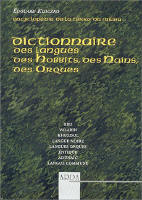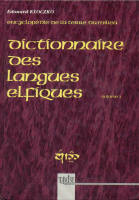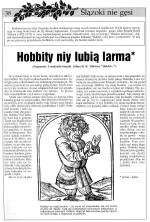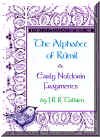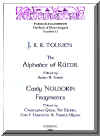![]()
Behind the leaves of lebethron.
Essay by Didier Willis
[February 19, 2003]
|
Renowned Tolkienian linguist from France, Didier Willis, is the author of an essay about the lebethron tree. It was first published as few messages at Lambengolmor mailing list. Willis' text is published at Lambengolmor as two PDF files. The first part [Part 1] is the main discussion, of general interest, focussing on the nature of the lebethron. The second part [Part 2], probably of more interest to the Elvish linguists, is a detailed etymological and linguistic analysis of the issue.
You can
find out what can be the etymology of the Sindarin name lebethron,
and you can read there a lot about botany! A very interesting linguistic
essay. [Source: Lambengolmor] |
![]()
The Atalante Fragments by Ale Bičan
[February 11, 2003]
|
Tolkienian linguistic website ELM by Ale Bičan from Czech Republic has been updated with a very interesting analysis of the Atalante fragments in Quenya as published in The Lost Road and Other Writings and Sauron Defeated by J. R. R. Tolkien. The aim of this analysis is to focus on particular words of the Fragments, an analysis of these words with their etymologies, and comparison of the use of these words in other Tolkien's text. A good deal of the text is spent on the comparison of different versions of the Fragments. The whole text can be found here.
ELM has been also updated with new names in Quenya Babybook, the éclats de poésie section created and poem laika, tyalie, karne, There is a Garden in her Face, and luine added, newwords updated, a new a-less composition added to a play and few more. |
![]()
Elvish Music by Jessica Butler
[January 29, 2003]
|
|
Dreaming about 'Elvish' music, of which we read in Tolkien's books, I have had vague imagination what such music would be. Jessica Butler, a musician from America, has made my dream real.
Jessica Rae Butler (24)
is a music student in Southern California,
in the United States. Currently she is
studying Vocal Performance, although she has a
background in instrumental as well.
She has been involved in music and performance
since she was a child, and she
loves all kinds of music. It is only
recently, however, that Jessica have dared
venture into composition at any length.
You can read more about Jessica on her
website. |
|
Western India, which
she had been studying for curiosity's sake.
This exploration into Tengwar and Sindarin,
combined with her love for
music, have inspired her to write the
'Elvish' music
she has been writing of
late. It is her opinion that Howard Shore
(composer for the Peter Jackson films) has
perfectly captured the essence of Elvish music, and the ethereal and
otherwordly feel of his music has stuck with
Jessica, and quite obviously influenced her
own compositions. She
currently have three compositions, two in Sindarin and one in Quenya,
and she hopes over time to
generate more (especially for Gwaith-i-Phethdain!) We present two Jessica Butler's compositions. Their lyrics are Aerlin in elvellyn o Thol Gannel by Eirien Tuilinn and Prophecy from the movie soundtrack (songs are works in progress, and the text are only borrowed). Music is published with kind permission of its author (Meneg hennaid!):
Aerlinn in elvellyn o Thol Gannel: words by Eirien Tuilinn, music by J. Butler Prophecy: words by Philippa Boyens, music by J. Butler |
|
![]()
QuenyaNumbers - perfect way to count in Quenya!
[January 18, 2003]
|
Alex Grigny de Castro, a Tolkienian linguist from Holland, presents the newest version of his useful program which lets us count in Quenya and write the numerals in Tengwar! QuenyaNumbers 2.3. is a freeware Windows executable which converts base-10 integer numerals to words in Tolkien's Elvish language Quenya, and vice-versa.
Version 2.3: on a white background, the numeric glyphs are shown. Alex used Dan Smith's Quenya fonts to make these glyphs. more significant digits are always on the right, no matter what choice you make for the transcribed text. For the duodecimal system, if the numeral 12 is involved, a double representation is shown: the glyphs on the right use the special symbol for 12.
Visit Alex Grigny de Castro's website!
[Source: QuenyaNumbers 2.3 documentation] |
![]()
Elvish in Polish TV!
[January 13, 2003]
|
On January 9, 2003 at 6 p.m. in Polish TV private channel TVN, in a talk-show entitled "Rozmowy w toku" (word-play which is hard to translate into English: 'Talk in tok' Polish tok means 'course', but it is to resemble English talk[-show]) presented people with unusual hobbies. Among the guests were Ryszard Derdzinski (Galadhorn) and his wife Klaudia (Eirien). One part of the program was devoted to Tolkien's languages and scripts. Pictures Nos. 1 and 2 show Ryszard and Klaudia who are talking about Tolkienian linguistics. Picture No. 3 shows Ewa Drzyzga, the host of the program, and picture No. 4 Ryszard writing her surname in Tengwar. Picture No. 5 shows E. Drzyzga giving Ryszard a special gift from TVN - a T-shirt with the title of the program in Quenya! On picture No. 6 you can see details of this T-shirt with the inscription: eqessi mittasse, which was prepared by another Polish linguist, Maciek Garbowski.
It was the first program in Polish TV in which you could hear about beautiful world of J.R.R. Tolkien's art-languages.
Polish resumé: Dnia 9 stycznia 2003 roku w programie "Rozmowy w toku" wystapili Ryszard (Galadhorn) i Klaudia (Eirien) Derdzinscy. Program byl okazja do zaprezentowania pieknego swiata jezyków J.R.R. Tolkiena. Galadhorn i Eirien opowiadali o lingwistyce tolkienowskiej (zdjecia 1 i 2). Galadhorn mial okazje zapisac nazwisko Ewy Drzyzgi pismem tengwar (zdjecie 4), a na koniec swojej prezentacji otrzymal od TVN T-shirt z napisem eqessi mittalmar czyli w quenya "Rozmowy w toku" (inskrypcje wykonal polski lingwista tolkienowski Maciek Garbowski). |
![]()
Edouard Kloczko's newest book
[January 11, 2003]
|
|
Edouard J. Kloczko's newest book Dictionnaire des langues des hobbits, des nains, des orques (or Dictionary of the Language of Hobbits, of Dwarves, of Orcs, Editions ARDA, 2002, price 23 ) is the fourth part of Encyclopédie de la Terre du Millieu (or Encyclopedia of Middle-earth). The book contains dictionaries, phonetics and grammar of the 'minor' Tolkien's languages: not only languages of Hobbits, Dwarves and Orcs, but also of Valarin (language of the Valar), Entish (language of the Ents), Adûnaic (language of Númenóre) and Common Speach (language of Middle-earth in the Third Age).
Edouard J. Kloczko (known as Laurifindil) born in 1963, a French linguist and translator of Polish descent (his family comes from Polish Lwow, today Lviv in the Ukraine) has published only first and fourth part of his Encyclopédie de la Terre du Millieu. The first book (see on the left) was devoted to Quenya and Lindárin (Tamise éditeur, ISBN 2-910681-03-3). Its last publication was in 1995. The second and third part of the Encyclopédie will be devoted to Sindarin and other Elvish languages.
Kloczko's books are edited with great care and thoroughness. Although they are published in French English-speaking readers will find there many important and interesting contents understandable for them. Gwaith-i-Phethdain strongly recommends Kloczko's books! |
![]()
Helge Fauskanger's Quenya dictionaries on-line!
[January 4, 2003]
|
Helge K. Fauskanger, an
author of
Ardalambion,
has
released the latest versions of
his
Quenya wordlists for free download.
There are three wordlists there, available
as RTF files: Quenya-English, English-Quenya
and a Reverse Wordlist (listing the words backwards, so that
words with the same endings are grouped together).
The last wordlist is a perfect tool for all 'Elvish' poets. Helge
hopes we will see a
Quenya Etymological Dictionary one day. [Source: Elfling] |
![]()
Fragments of "The Hobbit" in Silesian
[December 19, 2002]
| Silesian is a dialect of Polish used in the region of Upper Silesia (German Oberschlesien, Polish Górny Slask) in Poland. Silesian is a dialect of the area of Polish, German and Moravian (Czech dialect) influences. In 1990s, when communist regime ended, many books and shorter texts were written in Silesian. One of the most popular Silesian writers is Marek Szoltysek (his website). In his newest book Slazoki nie gesi (Rybnik 2002 ISBN 83-88966-014) Mr. Szoltysek gives us a short fragment of... The Hobbit in Silesian. It is the first such translation of J.R.R. Tolkien's text into this interesting speech. On the left you can see the page 38 with the beginning of The Hobbit "na slazko godka przelonaczony" (in Silesian: 'translated into language of Silesia"). |
|
Polish resumé: Informujemy, ze w najnowszej ksiazce Marka Szoltyska Slazoki nie gesi (Rybnik 2002 ISBN 83-88966-014) znajduje sie fragment... Hobbita J.R.R. Tolkiena przetlumaczony na dialekt górnoslaski. Powyzej znajduje sie reprodukcja strony 38 z tekstem pierwszych akapitów Hobbita po slasku. Jest to pierwszy w historii tekst Tolkiena przetlumaczony na mowe Górnoslazaków. |
![]()
Dragon Flame: Very useful linguistic tool!
[December 15, 2002]
|
Didier Willis, a known Tolkienian linguist from France, and his friends from Hiswelókë website have recently announced their newest Sindarin tool which name is Dragon Flame (v. 1.0). It is a freeware application including the Sindarin dictionary in hypertext, additional lexicons and a complete corpus of Sindarin texts by J.R.R. Tolkien. Dragon Flame should run on any recent Windows system (98, Me, XP, NT4, 2000). It can be downloaded from Didier's website. Gwaith-i-Phethdain strongly recommends Dragon Flame as one of the most comprehensive and useful linguistic tools for students of Tolkien's languages! It includes not only all the attested Sindarin (and Noldorin) words, but also provides us with very interesting etymologies by David Salo. |
|
Didier is an author of a very good Sindarin Dictionary. Its newest version can be downloaded from Didier's website too. See here for details. |
![]()
Ardalambion: Sindarin updates
[December 15, 2002]
|
Helge Fauskanger, an author of a very popular Tolkienian website Ardalambion, has updated his Sindarin articles according to the information from the last issue of Vinyar Tengwar (#44, see here). If you want to see the changes read Helge's texts: Sindarin - the Noble Tongue and Suggested Conjugation of Sindarin Verbs. |
![]()
Newly published Tolkien's books
[October 31, 2002]
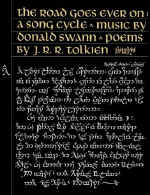
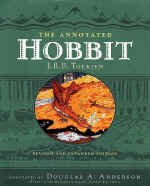
|
Two newly published books by J.R.R. Tolkien which are highly recommended for all Tolkienian linguists are Road Goes Ever On and The Annotated Hobbit. The first one, Road Goes Ever On, available for the first time after 25 years, is book of songs and sheet music, a collaboration between J. R. R. Tolkien and the composer Donald Swann. Professor Tolkien decorated the book in his own hand and added a detailed analysis and glossary of Elvish terms and lore occurring in Quenya Namárië and Sindarin A Elbereth Gilthoniel. This unique information appears nowhere else.
The
Annotated Hobbit
(last published in 1988) is another interesting book. Douglas A.
Anderson, a noted Tolkien scholar, has done an introduction and notes
with the full cooperation of Tolkien's family. To the text of the third
edition he has added many textual and revisional notes, runes, and a
bibliography of writings by JRRT and about him and his works. Notes
contain linguistic analysis of such names and terms as: dwarves, bagging
(cf. Baggins), belladonna, bilbo (cf. Bilbo),
Eriador, dwarves names from Dvergatal, Orcrist, Glamdring,
Esgaroth, Bladorthin, etc. |
![]()
[July 24, 2002]
|
|
Newest issue of Vinyar Tengwar provides us with very interesting materials concerning Quenya and Sindarin. It opens with a letter from Bill Welden, an author of Negation in Quenya (cf. VT#42), in which we can find a fragment of very late JRRT's notes (from 1970s ?) where Tolkien wrote: "ú should be negative particle". Very interesting if we compare it with Tolkien's arguments for lá as a negation particle.
Words of Joy. Five Catholic Prayers in Quenya Part Two (for Part One see here) is an analysis of Ortírielyanna (Sub Tuum |
|
Praesidium) and The Litany of Loreto translated by Tolkien into Quenya in 1950s. Editors provide us with facsimile of Tolkien's manuscripts and with very detailed analysis of the Quenya forms found in both prayers. Such words like sangie 'necessity', illume 'always' or raxe 'danger' are of great interest for every lambendil. We can find there also interesting theological terms like Elpino 'Christ' (p. 15) and Neldie 'Trinity' (p. 17). Editiorial notes should be considered with great care. They bring a lot of interesting information, e.g. on p. 20 we can find rules of the change of intervocalic s > r and the explanation of the origin of intervocalic v in Quenya.
Another text of great value is Ae Adar Nín or The Lord's Prayer in Sindarin (cf. p. 21). It's one of the longest texts in Grey Elvish. Many new forms can be found there: vi (lenited *mi ?) 'in', no 'be!' (imp.), caro den 'may they do' or 'may it will be done', bo 'on', sui 'as, alike', etc. Every "Sindarinist" should read the analysis of fragmentary (unfortunately!) Ae Adar Nín by Bill Welden!
The last text included in Vinyar Tengwar #44 is Alcar mi Tarmenel na Erun or the Gloria in Excelsis Deo in Quenya analyzed by Arden R. Smith (cf. p. 31). The versions of Alcar... presented by A. Smith come from mid-1960s.
Check the website www.elvish.org where you will find necessary information on the subscription of Vinyar Tengwar. |
![]()
Vinyar Tengwar #44 forthcoming
[June 3, 2002]
|
As Carl Hostetter, the editor of Vinyar Tengwar, informs the newest issue of his linguistic magazine is forthcoming. As we can read on his website this 40-page issue features the second part (of two) of a presentation and analysis of five hitherto unpublished Quenya texts by J.R.R. Tolkien (see VT 43 for part one), concluding with the Sub Tuum Praesidium and the Litany of Loreto. This issue also presents Tolkien's (partial) Sindarin translation of the Pater Noster, edited and analyzed by Bill Welden; and Tolkien's (partial) Quenya translations of the Gloria in Excelsis Deo, edited and analyzed by Arden R. Smith. Check the website www.elvish.org where you will find necessary information on the subscription of Vinyar Tengwar. |
![]()
Lambengolmor:
new mailing list devoted to Tolkien's languages
[June 3, 2002]
|
Carl Hostetter has created a new mailing list devoted to Tolkien's languages. As he writes: This group exists to serve those interested in the scholarly study and discussion of the invented languages of J.R.R. Tolkien. This list is strictly moderated (by yours truly). All posts must be concerned with Tolkien's invented languages. For more details, see the list announcement here. The Quenya word Lambengolmor means 'the Loremasters of Tongues'. |
![]()
New items on H. K. Fauskanger's Ardalambion
[June 3, 2002]
| Famous Ardalambion by Helge K. Fauskanger has presented two new texts: How many languages did Tolkien make? and The Lord's Prayer and Hail Mary (or detailed analysis of J.R.R. Tolkien's prayers). |
![]()
Ales Bican's website is now hosted on the E.L.F. domain
[March 26, 2002]
|
ELM or Ales Bican's
interesting website on the Tolkienian linguistics has changed its URL.
Now it is hosted on server space provided by the Elvish Linguistic
Fellowship. Its address is
http://www.elvish.org/elm.
ELM is an acronym for Eldalinwelemar 'Home for Elvish
poetry'.
Ales has written a very interesting essay on the so called Quenya Mystery Case. Every Elvish linguist should read this professional text! ELM contains also some Elvish compositions, Quenya Babybook, an essay "Quenya Spelling" by David Salo, "A Note on the so called Merin Sentence" by Ales Bican and some musical links. Congratulations Ales! |
![]()
Tyalië Tyelelliéva #18:
H. Fauskanger's Analysis of J.R.R. Tolkien's Catholic Prayers
[February 26, 2002]
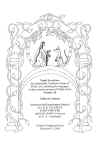
|
Today I have received the
18th issue of
Tyalië
Tyelelliéva with 70 pages of Syntactical and Etymological Analysis of
J.R.R. Tolkien's Lord's Prayer and Hail Mary in Quenya by Helge K.
Fauskanger. This long analysis provides us with many interesting guesses
and notes by the Tolkienian linguist from Norway concerning the
Christian prayers of J.R.R. Tolkien presented in the last issue of
Vinyar Tengwar (see below).
I recommend this publication. All the subscription information can be found here. |
![]()
Quenya Numbers v. 1.5
[February 26, 2002]
|
Alex
Grigny de Castro is an author of a very interesting Windows program which allows
you to calculate in Quenya. Writing down our decimal number and hitting
'calculate' you will see this number in duodecimal system and you will
be able to see its Quenya form. The program can be found
here
and here. |
![]()
J.R.R. Tolkien's Catholic Prayers in Quenya Part I
[February 26, 2002]
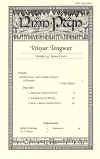
|
From Elvish Linguistic Fellowship website: This 40-page issue features the first part (of two) of a presentation and analysis of five hitherto unpublished Quenya texts by J.R.R. Tolkien, being his translations of five Catholic prayers: the Pater Noster, the Ave Maria, the Gloria Patri, the Sub Tuum Praesidium, and the Litany of Loreto. The first three of these are presented in this issue, and the last two will be presented in the next issue. All five texts have been edited by Patrick Wynne, Arden R. Smith, and Carl F. Hostetter. |
|
Tolkien's prayers are presented in a very careful and systematic way. Editors present original manuscripts and all the known Quenya texts of the prayers translated by J.R.R. Tolkien. Every Quenya form is commented and compared with other similar forms. This issue of VT is a treasury of interesting Quenya words from the conceptual phase of early 1950s including enge '[it] was' (sg. pa.t. of ëa 'be, exist') and several pronominal forms. The editors provide us with very interesting information in editorial notes. On p. 6 he writes about a restructure of the pronominal system that preceded the publication of the Revised Edition of The Lord of the Rings (in 1965). According to the editors this restructure resulted in the shift of -lm- to -lv- (-lw-?) as the marker of the 1 pl. inclusive and the endings in -mm- became dual (in the system from 1950s and the beginning of 1960s it was the marker of the 1 pl. exclusive). We hope to hear more about this interesting matter in Vinyar Tengwar #44 which will include Sub Tuum Praesidium, and the Litany of Loreto. The editors have announced that it will be published in March 2002. Check the website www.elvish.org where you will find necessary information on the subscription of Vinyar Tengwar. |
![]()
Rúmilian script and early Noldorin fragments:
new Parma Eldalamberon XIII
[January 10, 2002]

|
|
From Eldalamberon website: Parma Eldalamberon 'The Book of Elven-tongues' is a journal of the Elvish Linguistic Fellowship, a special interest group of the Mythopoeic Society. The forthcoming issue has two sections containing newly published writings by J. R. R. Tolkien: "The Alphabet of Rumil" edited by Arden R. Smith; and "Early Noldorin Fragments" edited by Christopher Gilson, Bill Welden, Carl F. Hostetter, and Patrick Wynne. Both of these have been prepared with the guidance of Christopher Tolkien and with the permission of the Tolkien Estate. The Rúmilian Sarati are the earliest of the Elvish writing systems devised by Tolkien, ultimately envisioned as the historical precursor to the Feanorian Tengwar, the Elvish script seen in The Lord of the Rings. "The Alphabet of Rúmil" is a facsimile edition of all of the examples of Rúmilian writing by Tolkien, including charts of the sounds represented by the letters and examples of both Elvish and English texts written in Rúmilian. Transcriptions of these texts and detailed commentary on the chronology of the documents and evolution of the conception of the writing system are included in this edition. "Early Noldorin Fragments" is a collection of Tolkien's word-lists and grammatical description of the Noldorin language from the 1920s. These trace the evolution the language from its beginnings as the Goldogrin of the "Gnomish Lexicon" to its conception as the Exilic Noldorin that would appear in "The Etymologies". These writings reveal the emergence of significant conceptual details, such the use of vowel mutation to mark Noldorin plural nouns, or the place of Old Noldorin in the internal history of the language. Detailed annotations and commentary on these conceptual developments in the documents are included in this edition. Parma Eldalamberon, Number 13, is a 166-page journal, in 8 1/2 x 11 inch format, with cover illustrations by Adam Victor Christensen. Individual copies are available for $25.00, which includes shipping anywhere in the world. The journal will be mailed in a padded envelope and sent by priority mail within the U.S. or via airmail to all other locations. Payment must be in U.S. funds, check or money-order payable to: Christopher Gilson, 10200 Miller Ave., Ste. 426, Cupertino, CA 95014, USA. [Source: Eldalamberon] |
![]()
Sindarin humor in Beyond Bree
[January 10, 2002]
|
Do you know that our famous Sindarin Ai na vedui Dúnadan! Mae govannen! (LotR, book 1) means: 'It's not a drunken Dúnadan! It's a blacksmith!' in Middle Welsh (an ancestor of modern Welsh spoken in today Wales)? Newest Beyond Bree (December 2001, p. 6) contains a short report by Carol Drollinger from an online course of Welsh at the Barnes and Noble University. Carol compares Sindarin with Middle Welsh. Many words look very similar, i.e. imperative verbal ending is -o in both. The same with the third person past tense ending -ant, etc. Carol writes: If you know Middle Welsh, it is very difficult to read Sindarin and not try to translate it as such. Sometimes the result can be like this with Dúnadan (see above) ;-) P.S. I have forgotten to mention that in Beyond Bree of June 2001 David Salo published his Sindarin translation of the famous song by The Beatles, "Let It Be" (in Sindarin Davo Sin). Its refrain is: Davo sin, davo sin, lhusso i phith saelas, davo sin... Splendid work! [Source: Beyond Bree] |
![]()
David Salo on Discovery
[December 18, 2001]
|
At Discovery.ca and EXN.ca you can find an examination of Tolkien's mystical world through the eyes of earthly scientists. One of them is David Salo, a known Tolkienian linguist of whom Liv Tyler said "There was this mystery man we used to have to call: we'd fax him the English and he'd fax back the Elvish." In a short film presented by Discovery David Salo tells a lot about the languages of Middle-earth, especially about the Elvish languages; we can hear him reciting his own Bruinen Spell (see here) and we can see his beautiful calligraphy. I recommend this film. A very nice meeting with a famous linguist being an author of the Elvish dialogs in the LotR movie. [Source: Discovery.ca. More information on David Salo you will find here] |
![]()
Quenya Translator ready!
[December 18, 2001]
|
As John Wordsworth informs he has uploaded the simple version of Quenya Translator to his website Utúvielyë Quenya. QT translates single words from English to Quenya and from Quenya to English at the moment, and the word-list is not still complete, but its a good start. John promises to work on the main Translator useful to translate whole phrases! Go on, John! Good work! [Source: Utúvielyë Quenya] |
![]()
The Globe and Mail: on Tolkien's secret vice
[December 18, 2001]
|
On December 15 The Globe and Mail has presented an article entitled Lord of the lingo. Its author, Alanna Mitchell writes about the beginnings of the linguistic passion of J.R.R. Tolkien. She also reports the views of Helge K. Fauskanger and Carl F. Hostetter on the present situation of Tolkien's languages. In the end of the article you will find a Quenya translation of Pater noster by Patrick Wynne and Carl F. Hostetter. [Source: Elfing, message from Carl. F. Hostetter. R. D.] |
![]()
Vinyar Tengwar #43 in January 2002?
[November 27, 2001]
|
As Carl F. Hostetter informs on Elfling the newest issue of Vinyar Tengwar, to be published in January 2002, will contain a complete presentation and analysis of all of the Quenya versions of J.R.R. Tolkien's prayers Paternoster and Ave Maria, as well as those of three other prayers (the Gloria Patri, the Sub Tuum, and the Litany of Loreto), making full use of associated notes and of Tolkien's unpublished papers. Great news! [Source: Elfling, message from Carl F. Hostetter. R. D.] |
![]()
Sotheby's revelations: letters by J.R.R. Tolkien
[November 26, 2001]
|
Among Sotheby's 14 actual Tolkien items to be auctioned by on December 13 there are letters from J.R.R. Tolkien, and there are detailed pictures of them too. Two of these letters contain a very interesting linguistic material. One of them (to Anthony D. Howlett, from May 28, 1969) shows a discussion of the name Rivendell, with examples of tengwa renderings of Imladrist and Rivendell. The accompanying text is also of great interest. It explains that Sindarin imlad means 'flat-floored valley' and that rist is 'cleft'. Best English rendering of this name is, according to Tolkien, Corfedale or even Corfebottom. Another letter (to Peter Alford, from the years 1956-58) provides a lengthy discussion of the Elvish greeting: Elen síla lúmenn' ómentielmo. One thing attracts our attention: Tolkien explains the pronominal possessive suffix -lma as a variety of -lme 'we' which in fact means: 'you and I/we'. The Quenya verb sil- 'shine white' is derived - according to this letter - from the stem ÞIL-. [Source: Elfling, message from Anders Stenström. R. D.] |
![]()
Newly-published Tolkien recording
[November 26, 2001]
|
Carl F. Hostetter wrote on this recording on
TolkLang:
"As such, this (spoken) version differs from the previously
published (plainchant) recording of Namárie that Tolkien made at
the home of George Sayer in 1952. This new recording agrees exactly with
the most current LotR-version of Namárie that was achieved in
the Revised Edition of 1965 (including avánier for previous vánier).
Furthermore, to my ear, Tolkien's pronunciation in this new version is
much more careful than that of the earlier version, especially in the
opening lines (for instance, he more clearly distinguishes long from
short vowels, and vowels in general are less anglicized). I also observe
an interesting tendency for Tolkien to pronounce medial i as a
semi-vowel". |
![]()
Tyalië Tyelelliéva #17 is ready
[November 10, 2001]

|
Lisa Star announces that newest issue of Tyalië Tyelelliéva is ready! It contains: a lot of material on Sôval Phârë or Common Speech, poems by Sergi Oliva Valls and Anna Jivilo, and an original composition by Ryszard Derdzinski of Sam Gamgee's letter to Aragorn with tengwar calligraphy. There is also an article by Rhona Beare about Tolkien's references to swallows. It has already been sent to the subscribers. All the subscription information can be found here. |
|
Update! Lisa Star is going to publish another issue of Tyalië Tyelelliéva before the New Year's Day. Issue #18, that according to Lisa it will be published in December 2001, will contain Helge Fauskanger's analysis of the Tolkien's prayers in Quenya: Átaremma ('Our Father') and Aia Maria ('Hail Mary'). R.D. |
|
![]()







